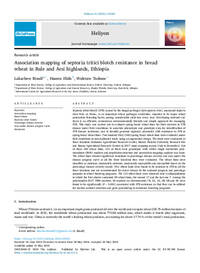Association mapping of septoria tritici blotch resistance in bread wheat in Bale and Arsi highlands, Ethiopia

Authors:
Septoria tritici blotch (STB) caused by the fungal pathogen Zymoseptoria tritici, anamorph Septoria tritici Rob. ex Desm., is an important wheat pathogen worldwide, reported to be major wheat production threating factor, posing considerable yield loss every year. Developing resistant cultivars is an efficient, economical, environmentally friendly and simple approach for managing STB. This study was carried out to evaluate spring bread wheat lines for their reaction to STB disease under field conditions; to associate phenotypic and genotypic data for identification of STB disease resistance; and to identify genomic region(s) associated with resistance to STB in spring bread wheat lines. Two hundred forty (240) spring bread wheat lines were evaluated under field conditions in non-replicated trials, using an augmented design. The trials were conducted at three locations (Kulumsa Agricultural Research Center, Madda Walabu University Research Site and Sinana Agricultural Research Center) in 2017 main cropping season (July to December). Out of these 240 wheat lines, 123 of them were genotyped with 10263 single nucleotide polymorphism (SNPs) markers and population structure and association mapping analysis was done. The wheat lines showed significant variations in percentage disease severity and area under the disease progress curve at all the three locations they were evaluated. The wheat lines were classified as resistant, moderately resistant, moderately susceptible and susceptible based on the percentage disease severity scored. Five wheat lines were found to be resistant to STB in all the three locations and are recommended for direct release by the national program and parentage purposes in wheat breeding programs. The 123 wheat lines were clustered into 3 subpopulations in which the first cluster contained 99 wheat lines; the second 17 and the last one 7. Among the polymorphic 8127 SNPs markers, 26 markers on chromosomes 7B, 1D, 3A, 2B, 6B and 3D were found to be significantly (P < 0.001) associated with STB resistance so that they can be utilized for marker assisted selection and gene pyramiding in resistance breeding programs.
